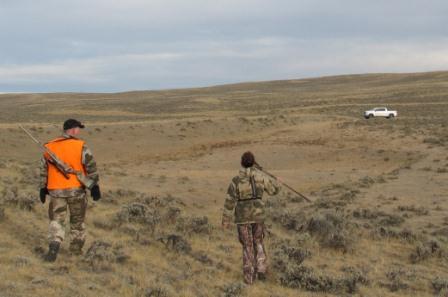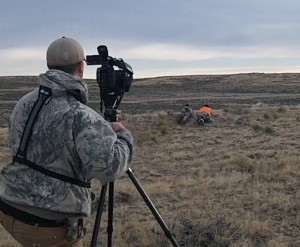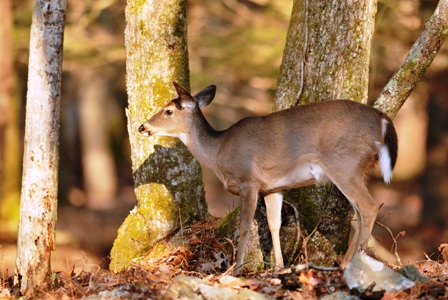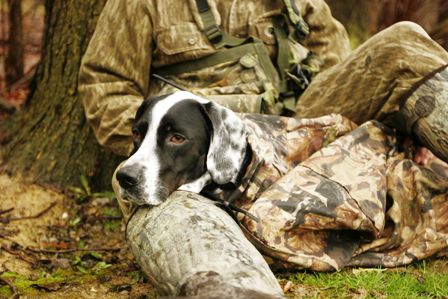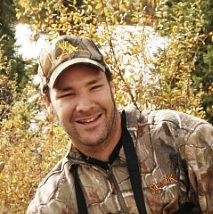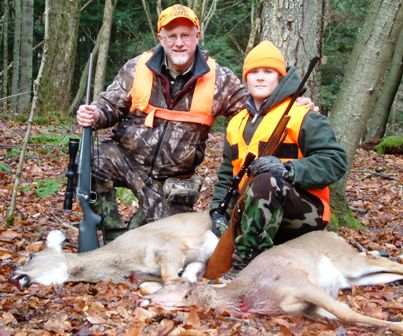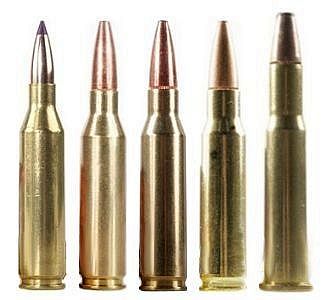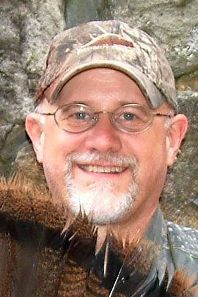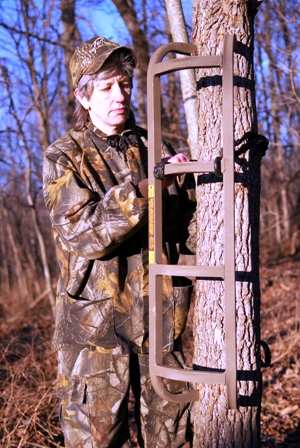Joey Peterson’s Free Antelope Hunt Filmed For The Sportsman Channel
By Patrick Carrothers, President & CEO of Havalon Knives
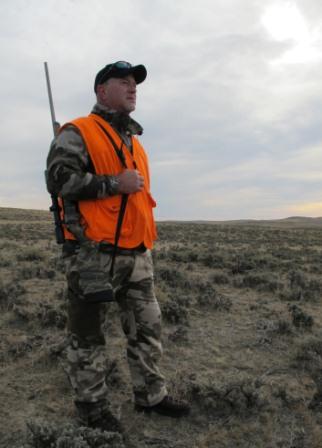
Joey Peterson surveys the Wyoming landscape for antelope at the start of his Free Havalon
Sweepstakes Hunt.
I knew it would be windy in central Wyoming, but I didn’t expect the snow storm and low of 19 degrees that hit the night before we arrived. It was the first week of October.
By the time I met Joey in the Casper airport the sun was burning off the snow and the temperature was rising. Good omen.
Joey Peterson, of Daphne, Alabama, won Havalon Knives’ 2012 Free Hunt Sweepstakes. I had the good fortune to be his host while Joey enjoyed an all-expenses-paid rifle antelope hunt guided by Table Mountain Outfitters in the rolling high plains of central Wyoming.
Joey and I hit it off from the start. We packed his gear in my rented Chevy Impala and headed for Douglas, about 60 miles east.
I asked Joey how he felt when he realized he won the Free Hunt Sweepstakes. “I was reluctant to respond when I received the email notification,” he said. “I thought it had to be a scam! I called and talked to Angie Denny to see if she really knew you guys.” I told him there was nothing to worry about, we just needed his credit card number and we would reimburse him for all the costs. Just kidding!
We were scheduled to meet Scott Denny and Angie that afternoon, stars of The LIFE At Table Mountain show on The Sportsman Channel. I knew Joey was a little nervous about being taped for television. “You’ll get used to the video camera recording your every move, especially after your first miss,” I teased.
This section of Wyoming is classic western high plains country. The short grass prairie runs hundreds of miles in all directions. Driving across the rolling sage brush hills we saw occasional rocky buttes jutting into the big sky with vast basins stretching between ridges. Elevation 6000 ft. Antelope country. We could see herds in the distance. Lots of them.
Paleontologists say there were once 12 species of pronghorn in North America. By the time modern humans entered this country, five species remained. The low point for pronghorn came around 1920, when only 13,000 animals, all the same species, were the only antelope remaining on our continent.
Today Over 1 Million Antelope Roam
Wise conservationists in the mountain states and Canada coordinated a resource management program to save the pronghorn from the fate of the buffalo. Thanks to this united effort, today there are more than one million antelope roaming North America. In fact, antelope outnumber people in Wyoming by a wide margin.

High rock at side of natural bridge, near Fort Fetterman, Douglas. Converse County, Wyoming. – NARA – 517392 (Photo credit: Wikipedia)
At Douglas we turned north to travel 26 miles to the Table Mountain bunkhouse. We passed the site of Fort Fetterman, an Army outpost founded in 1867 following a battle with a Sioux tribe that killed Lt. Col. W.J. Fetterman and 81 US soldiers. Joey and I couldn’t resist joking about seeing a line of Indians on horseback on the ridges that loomed above us. It was a scene spliced from a Hollywood western.
Stark, dry, barren country to our Eastern eyes. Almost like being on a different planet. But still beautiful with the sheer magnitude of open landscape and big sky vistas.
Just outside Douglas we passed a towering black jackalope sculpture high atop a ridge silhouetted against the sun. This reminded me that Douglas is the home of the Annual Jackalope Festival. For the uninitiated, the jackalope is a mythic creature half antelope and half rabbit. For some reason, the statue looked more like a deer/rabbit combo. Either way, we knew we were entering jackalope country – better keep our eyes open.
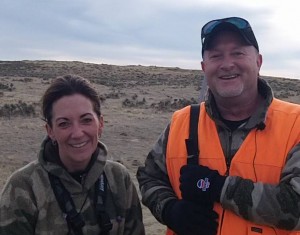
Joey Petersen is ready to hunt antelope with Angie Denny, guide, co-owner of Table Mountain Outfitters, and co-star of “The LIFE at Table Mountain” on
The Sportsman Channel.
When we pulled into the bunkhouse lot we were greeted by Angie Denny, just returning from a successful hunt with two happy hunters in her truck along with a mule deer and a pronghorn on the flatbed. Another good omen.
Angie and Scott Denny, the owners of Table Mountain Outfitters, have leases for exclusive hunting in Wyoming, Idaho, North Dakota and Nebraska. The lease we would hunt covered 100,000 acres of prime mule deer and pronghorn country.
Angie and Scott have a stellar reputation as guides. That means they get you to the kill shot. Joey and I could see the evidence hanging in the skinning shed. Three animals gutted, skinned and caped and it was only 3:00 pm. Two more waited in Angie’s truck. Scott and a few other guides had not yet returned.
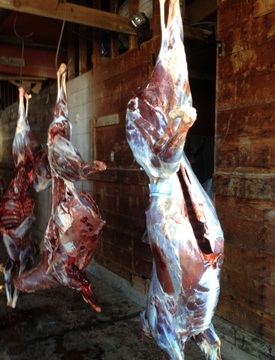
The skinning shed at Table Mountain Outfitters Wyoming ranch was always full. There’s no better review than that for a hunting outfitter.
If you want to put meat on the table and have a shot at a trophy, there’s no better recommendation for guides than a full skinning shed.
By evening after all the guides and hunting parties returned, I had never seen so much meat hanging in one place.
Joey used the late afternoon sunlight to practice his long distance shooting.
I had a chance to visit with a few of the fine hunters returning to the bunkhouse after their hunts. After dinner we learned that our guide tomorrow would be Angie Denny.
Very cool!
The Hunt Begins
Joey and I ate light at 6:30 breakfast. I may have had more butterflies than Joey; he looked calm and ready. I was trembling with excitement at seeing my first jackalope.
We finished our biscuits with sausage gravy and were ready to roll (best gravy ever). Angie was talking with a group of late hunters so we settled down and rechecked our gear. We were pumped for a day of trekking the high prairie hills in search of Joey’s trophy pronghorn.
7:30 am: We had checked our gear so many times we knew we were ready for our close up. 8:00 am: Joey and I looked at each other wondering if our hunt would ever get started. Angie was still chatting in the kitchen with the camera man for our hunt and a few guests.
We clearly did not know the “Western Hunt for TV” routine. Joey being from Alabama, and me from Ohio, we expected to be out in the field before sunrise, setting up early so not to spook the game.
We learned (duh!) that good sunlight was needed for the camera. And forget about stalking quietly; we would find our herd from a white Toyota Tundra!
First Crisis: Dumping The Coke
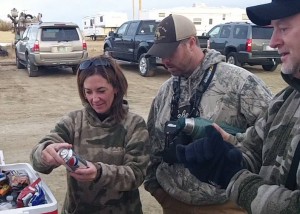
The big switch from Coke to Pepsi in the hunting cooler. Joey works for Pepsi. “No way I’m hunting with Coke in the truck,” Joey said.
No, not that coke. Joey works for Pepsi. To his horror he found only Coca-Cola sodas in the truck cooler. No way Joey could focus with Coke in the cooler! We had fun with that one! Angie was very sweet about it and loaded the Pepsi herself. Finally, about 9:00 am we were on a Pepsi-fueled hunt, in the truck and rolling.
In this vast neck of the woods, a four-wheel drive is the hunter’s best friend. Remember, we had 100,000 acres we might need to cover. Angie drove with Joey riding shotgun. Dustin and I rode in the back seat. From this location we saw wind turbines in the distance. Oil pumping rigs obscured every view. White two foot high tubes dotted the landscape.
“What are those white tubes,” I asked. “Vents for uranium mines,” Dustin answered. This landscape was more industrial than Wild West. I was worried. Is this really where we’re going to hunt?
Angie drove another five minutes and we crested a ridge and stopped. Before us stretched a classic western scene as far as the eye could see. Rolling hills and vast shallow valleys all the way to the horizon. Not an oil rig in sight.
Everyone glassed for signs of antelope. And there far below, they were grazing.
Angie drove in a wide arc to the right side of the herd. She stopped on the downhill of a ridge with our white truck in full view of the antelope. We got out and glassed for a trophy buck and the herd spooked, running left into a big basin.
That’s exactly what Angie wanted. She was using the truck to push the herd into an area offering Joey a bunch of ridges from which to shoot. She drove this time in a low wide arc to our left in the direction of the herd. But I could tell from the arc she was travelling she was putting Joey out ahead and above where that herd was running.
“Stay Low At The Ridge. Everybody Quiet.”
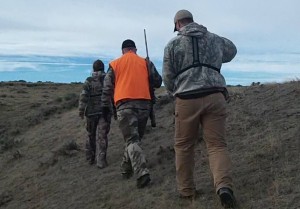
Angie leads Joey along a ridge with Dustin taping every move for The LIFE at Table Mountain show during Joey’s Wyoming antelope hunt.
Angie stopped the truck far back from a ridge line. “Single file,” she said. “I go first. Joey, follow me and watch my signals. Dustin is next and Patrick you go last. Stay low at the ridge. Everybody quiet.” Yes ma’am. No joking now. This was it.
Angie led us up through sage brush and rocks then went down on one knee. She signaled everybody to crouch as we came over the ridge to glass for the herd. Out maybe 500 yards we saw a lot of does and a few young bucks but no trophies.
Angie motioned us back down then led us single file to another ridge off to our left. On foot the terrain is more rugged than it looks from the road. I was intently watching the ground so I didn’t kick a rock or trip over one and spook our quarry. Angie suddenly signaled us to stop and get low.
She took Joey and they crept up to a ridge line that would provide cover. More glassing. Dustin and I were exposed to the big basin below us so we went down to one knee. Dustin feverishly started setting up his camera on a tripod. We were all looking into a dense 1000 yard long thicket of scrub brush and rock.
Angie pointed. I heard her whisper something to Joey. We spotted a doe emerging. After a minute a buck walked into sight. Joey and Angie whispered, probably discussing if this buck was acceptable to Joey. Dustin had his camera rolling.
The wind was constant but light. The distance to the buck I guessed at 250 yards. Joey placed the cross hairs on his Steyr 7mm Mag over the pronghorn. No sound but the wind.
The Steyr exploded the silence. “Missed” Angie said above a whisper but still very calm.
Joey later said he was thinking, “How could I have missed! I will never live this one down. I should have practiced in the prone position.” The doe bolted. Luckily, the buck seemed stunned and just stood there.
“Fire again” came the quiet command from Angie. This was a hit, but the buck did not go down. Just staggered in a circle. “Fire again.” This shot hit the buck’s shoulder, rocking it, and everybody thought that was the kill shot. Everybody except Angie. “Fire again” Angie said.
Joey hadn’t told anybody yet, but he only brought four bullets. This was his last chance.
He dug the round out of a pocket, chambered it, fixed his target in the scope, and took a deep breath. He squeezed off his last shot. The bullet hit the neck and the pronghorn went down!
Joey Gets The Hollywood Treatment

“That’s the fastest hunt I’ve ever been on,” says Joey Peterson. The after-hunt photography shown here may have taken longer than the actual hunt!
It didn’t take long for our cameramen to hustle to Joey and start capturing the high fives and hugs from Angie on video. That’s when the Hollywood treatment began for Joey.
He had to reenact several scenes to make sure the video was really good for the TV show. Then he had to pose for a round of still photography. I wouldn’t be surprised if the photography didn’t take longer than the actual hunt!
Before we had started out that morning, I asked Dustin how long he thought we would be hunting. “We’ll probably be back before lunch,” he answered. I thought he was joking. Actually, we were back around 11:00 am. “The fastest hunt I’ve ever been on,” Joey said. Trophy, meat on the table, done!
The speed of the hunt is a testament to the skill of our guide, Angie Denny. She knew from years of experience how to influence the movement of that herd. She pushed the antelope into a funnel knowing that would give Joey a shot he could make, in this case exactly 229 yards. Immediately after the clean video was shot, Angie began taking still photographs. When we had hiked out to Joey’s antelope, Angie was the one who gutted the animal. Back at the skinning shed, Angie skinned and caped. She can do it all!
After it was all over I asked Joey a few questions:
What did you think of the skills of our guide?
“Angie knew the area and the terrain well. She was awesome and very dedicated to my success and satisfaction. I was also impressed that all the other hunters tagged out while I was here.”
How did it feel being taped for TV?
“Actually being taped was not on my mind until it came time for the shot.”
Did you enjoy your Free Havalon Hunt?
“Being from the South, I’m used to close shots in wooded areas with vegetation. The terrain here was amazing, with it’s wide open rolling hills and the large number of mule deer and antelope.
“This was truly a once-in-a-lifetime opportunity and I am grateful to you and Havalon Knives for an incredible all-expense-paid trip, and to Scott and Angie Denny at Table Mountain Outfitters for a memorable hunting experience.”
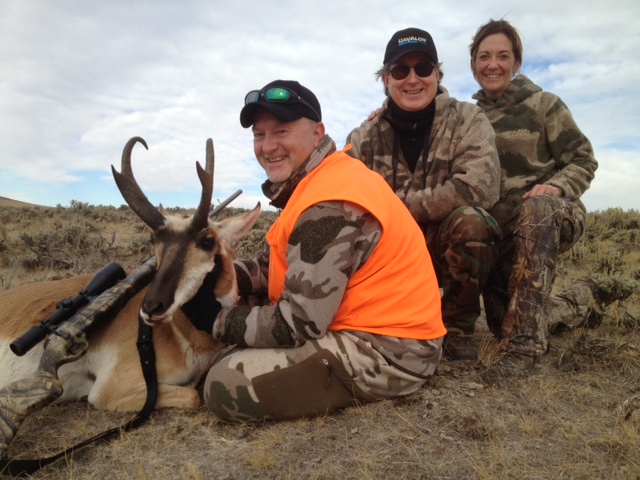
Joey Peterson, Patrick Carrothers and Angie Denny in Wyoming for the 2012 Havalon Knives Free Hunt.
Watch for your chance to win next year!
Thank you, Joey, for being a true class-act guy and an excellent hunter. Hope we get to hunt together again sometime soon.
A special hello goes out to Greg Kouba from Nebraska, Dane Martindell from New Jersey and John Johnson and Bob Walkowiak, both from Michigan. Enjoyed meeting you guys as well as everyone else in camp, just too many to mention!
We’ll be posting a video of the hunt so check back soon. And watch The LIFE at Table Mountain on The Sportsman Channel to see Joey hitting the big time on TV!
Ever been west on an antelope hunt? Share a comment below:
9,886 total views, no views today



